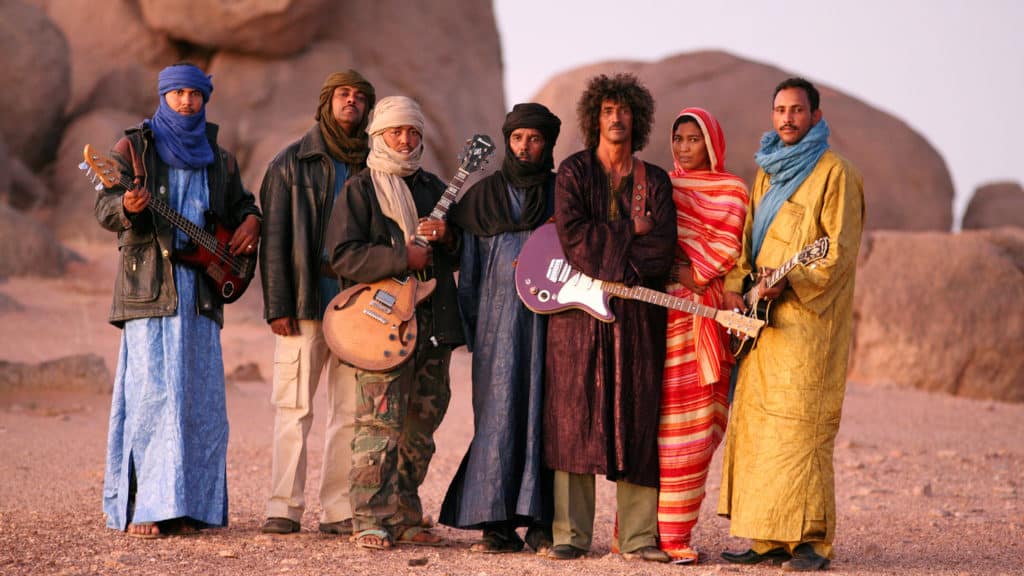Re: Winter 2009, Volume 43 (2) PAGES 168-177 – “Ni Sauvage, ni Barbare, The Cultivation of “culture” in the Moroccan Amazigh Movement“ by Paul Silverstein, Reed College. Review of Middle East Studies © 2009 Middle East Studies Association of North America (MESA)
Having just found this article on the internet, at the late date of February 2017, I am responding to Paul Silverstein’s remarks on this Canadian/Moroccan documentary produced by Roger Cantin in 2008, and I am doing so for a number of substantial reasons. As the President of the Tazzla Institute for Cultural Diversity (1993-Present), I have consistently spoken and written to promote the Amazigh culture of North Africa, and that of Morocco more particularly. I was born and grew up in that land. Furthermore, because of my mother’s Algerian judeo-berber origin, and because I was exposed to rural Berber traditions of Morocco in early childhood and adolescence, I selected Berbers of Morocco as a specialization for my doctoral anthropological studies at Stanford University. I became an activist in the Amazigh movement of Morocco some forty years ago and have never stopped supporting linguistic and cultural efforts of the part of Amazigh colleagues and activists. I am very familiar with this documentary which I presented to American audiences in January 2009 in Los Angeles, as a US Premiere of the Amazigh Film Festival I created in 2008, entering now its 9th annual year. The Tazzla Institute reintroduced it as well in 2010 at the United Nations of New York during a special annual event Tazzla Institute created and sponsored under the umbrella of UNESCO’s Culture of Peace Program, which bears the name of “Creating Peace through the Arts.”
The work of the Tazzla Institute for Cultural Diversity precedes the 1994 United Nations Convention which affirmed that “Cultural diversity is a cherished asset for the advancement and welfare of humanity at large and should be valued, enjoyed, genuinely accepted and embraced as a permanent feature which enriches our societies.” It is my sincere hope that my response to the essay offered by Paul Silverstein on the cultivation of culture in the Moroccan Amazigh movement published in this journal of Middle East studies, regarding a documentary I personally selected nearly ten years ago to bring attention to the similarities of goals and means between Amerindian indigenous peoples and Amazigh autochthonous peoples of my native land, will be indeed well received by its academic readers.[ads1]
Before I delve in the core issues raised by the Silverstein review, I would like to add to the background of my experience and achievement as a Moroccan Amazigh activist: I was instrumental in the selection of an American Indian activist to accompany me to the first international World Amazigh Conference that took place in Tafira, Grand Canary island, in August 1997. I sought Roberto Cruz, Papago activist of Arizona, a personal friend and Board member of the International Indian Treaty Council, for this role of mediation between cultures. He actually opened the Conference with a prayer in his native language, and conveyed to the assembly of Imazighen from various countries of North Africa the greetings and support of the American Indian Movement. At the same conference, I created a venue where this Indian activist could meet in private with Tuareg representatives of Mali and Niger in order to discuss matters of common interest in their struggles. At that meeting, I officiated as translator between Tuareg activists who spoke no English, but spoke French and Roberto Cruz who spoke no French but spoke English. Being fully bi-lingual in French and English, I was the intermediary in a long fruitful exchange between the two parties. Particularly moving was the translation of the poem recited by the great poet Hawad of Niger who opened the discussion on the Tuareg side. The similarities of viewpoints, of struggles, and of goals, were outlined and exchanged during several hours between Amerindians and North Africans.
Let me further present my profile as one of those Moroccan Amazigh activists targeted by Silverstein. I dedicated my entire professional life to American Indian and Amazigh issues, as a scholar and an activist, and created the Tazzla Institute to promote, protect and celebrate the Amazigh culture and Amazigh artists. I put together the first and only Amazigh Film Festival in the United States, and have presented the little known Amazigh (Berber and Tuareg) culture to Anglophone audiences of America for several years, in Los Angeles, New York and Boston. Selecting the documentary “Ni Sauvage, ni Barbare” was one of my first choices for this Amazigh Film Festival, as it was mentioned and recommended to me by no other than one of its protagonists, the Amazigh artist Lahbib Fouad (Yeschou) who leads the Berber side of this outstanding documentary. I liked the message it presented, which I knew to be a very poignant and valid one, given my own experience of the two cultures. It is relevant here to mention that I spent years on an Indian reservation, worked with the American Indian Movement and International Indian Treaty Council leaders, and created a very successful photo project with traditional Lakota elders, which I conceived and directed from 1983 to 1986 on the Pine Ridge Indian reservation of South Dakota. Upon my return to California, I opened an American Indian gallery, “Lakota Contemporary Designs” and was retained by the American Indian Alliance of Marin County to produce a community television series, “We are Still Here” featuring members of various Indian nations residing in that county. I then proceeded to create another series on the Amazigh culture of Morocco. The last two series I produced in Los Angeles were “Amazigh Weekly News” and “The Russell Means Show” in which I asked this famous American Indian activist, a close friend of mine, to host a number of half hour programs. In 2007, I was asked to present a week’s segment on Amazigh Arts to a group of 20 or so professor/students during the first Berber Institute held at the Oregon State University, Corvallis, Oregon. Though my name is probably little known, I imagine, in the academic world of the United States, I have written numerous published articles and books on both cultures. If anyone has “cultivated” the culture of the Amazigh Movement in Morocco, as well as that of American Indians, I , among all anthropologists, scholars and activists, undoubtedly have.
‘Ni Sauvage, ni Barbare” is the French title of this film. Paul Silverstein translates it as “Neither Savage, nor Barbaric” and even offers a quip by an unknown Moroccan (surely not an Amazigh activist?) as “Half Savage, half Barbaric.” Silverstein simply omits, or appears to be unaware of the actual title for this documentary in English, which is “On Native Lands.” As I write this analysis in English, I will continue to refer to the documentary by its correct name, “On Native Lands.” Another item of vocabulary is also going to differ from the Silverstein review in my analysis: the plural form of Amazigh is “Imazighen.” Wherever the term will be used to refer to Amazigh people in the plural form, the correct term of “Imazighen” will be used in this response to the Silverstein review.
“On Native Lands” gives a voice to an Amazigh artist and researcher at IRCAM (Royal Institute of Amazigh Studies, Rabat, Morocco), Lahbib Fouad, also known by the name of Yeschou, and an Innu singer, composer and activist from Labrador named Florent Vollant; through them, the film explores such issues as the marginalization of autochthonous peoples in North America and in North Africa, the question of cultural assimilation, the centrality of art in the maintenance of traditional values and in the grounding of identity. The respectful use of the environment is opposed to that of exploitation, and ritual links those notions. Silverstein advances that the protection of cultivated lands is claimed by groups who invoke their nomadic origins, and in doing so, he ignores the enormous diversity of lifestyles among Berbers or Imazighen of Morocco, from nomadic to semi-nomadic and sedentary ones; he also imputes the notion of “ethical stewardship of the environment” to colonial ethnologists, thereby concluding that the adoption of such claim is not only not new, but borrowed from colonial thinking. Here, I would like to disagree firmly and refer the readers of this article to my book “Tazz’unt, Ritual, Ecology and Social Order in the Tassaoute Valley of the High Atlas of Morocco” (2011) where this very topic is thoroughly discussed with quotes from famous post-colonial anthropologists on the ancient practices of various tribal groups, from Papua New Guinea to the Amazon River, in regards to such ethical stewardship.
Silverstein sees in such attempts at survival on the part of autochthonous peoples the character of “selfprimitivism” and makes the stupendous blunder of distinguishing Amazigh culture from Berber culture, as he asserts that the “underlying narrative” participates in what has been termed “the myth of the ecologically noble savage.” He errs in doing so, as “Berber” has simply been an external appellation for peoples who have called themselves “Imazighen” (Singular “Amazigh”) from the time of the pharaonic rulers of Egypt and before. The Amazigh culture is the ancient way of life of the peoples of North Africa whom outsiders have called “Berbers”. Silverstein develops his review on the basis of this duality of perspective, Berber on one hand, and Amazigh on the other. And he concludes that “Berber and Amazigh cultures, whatever their overlap, prove to be distinct socio-political realities.” The Tamazight language used in the central regions of Morocco and the Tamasheq language which is used by the Tuaregs of the Sahara desert both reflect what is evident throughout the North African territory called “Tamazgha” by autochthonous peoples, that the millennia old traditions of that land do belong to the peoples who have for centuries called themselves Amazigh/Imazighen. In my first book published in 2001, titled “The Shining Ones: Etymological Essay on the Amazigh Roots of Ancient Egyptian Civilization” , I clearly define the Egyptian understanding of the land of “Tamazgha” as land (“Ta”) of the Mazices (“Mazigh” ) or Libyan people who dwelt from the west bank of the Nile to the Atlantic Ocean. The expression “Tamaz-ra” in archaic Egyptian hieroglyphs refers to those who are sun-worshippers, who adore the sun, and they are said to be the peoples who inhabit the territory west of the Nile called Libya. Present day Berber people are firmly rejecting the external label put on them in a pejorative way, one of “Barbaric” people, and have re-affirmed their own ancestral name of Amazigh. The distinction which Silverstein proposes in his argument as he invents two different “socio-political realities” of Berber and Amazigh cultures, is not factual, and only serves a spurious narrative.
What is remarkably absent from that narrative and all of Silverstein’s analysis is the spiritual dimension present in the discourse of both the Innu singer and the Amazigh artist and their families. It is this element which links them, indeed which links all the components of the film, from the stones carefully selected for the sweat-lodge ritual to the artwork and the songs shared between the cultural representatives of the two continents. Such a perspective was not particularly held, as Silverstein suggests, by “colonial anthropology” but rather brought forth in a fairly recent past by post colonial anthropologists. The “structural nostalgia” which he notes exists only in his mind, and not in the realities of space and time as understood and lived by earth peoples, the Berbers, and the Innu people. Silverstein writes: ” Such a self-primitivising visions of Berber nature and culture informs explicit enactments of Berber politics.” Grammatically incorrect (a vision informs, or visions inform would have been correct English), this statement is also ludicrous. Here the argument of “self-primitivism” totally ignores the power of art, ritual , poetry and language in the creation and maintenance of any ethnic identity which struggles to survive in the face of colossal forces seeking its eradication. Silverstein indeed does not address the issue of identity, which is the central formidable issue common to all marginalized autochthonous groups of the world. In the film, one of my friends, one of the leading Amazigh activists of Morocco, head of Tamaynut, an Amazigh association which has over 30 branches throughout Morocco, and at one point representative of all African autochthonous groups at the United Nations Forum on Indigenous Peoples (IPACC), Hassan Id Belkhassam clearly states: “Autochthonous peoples throughout the world are denied their lands, their resources, their identity.”
The review pursues in raising the question of the place of Harratin among Imazighen, whom Silverstein represents by the color of their skin, “black”, and not by their known ethnic origins and social status among Imazighen. This is serious, as the imputation of racism is invoked in Silverstein’s review. As I wrote in an essay published in “Fifty Years in America , Anthropological essays” (2013), titled “Islam and the enslavement of Africans”:
“The Harratin have mysterious origins, which scholars have long debated. They are more closely related, genetically, to the Berbers of North Africa than to Black Africans, and yet they are a blackskinned population. Some scholars have seen in them the direct descendants of the original prehistoric inhabitants of the Sahara. They once worked in the oases of the desert as serfs or domestic servants of the Tuaregs, and considered themselves closely allied to them, forming a class category, which was not equated by Arabs or Tuaregs with that of slaves. Indeed the Arabic word for slave is “Abd,” a word not applied to Harratin people. At the time Moulay Ismail gathered his elite black troops (14th century,) his general El Bakhri conscripted some Harratin, to the outcry of the Scholars of Fez and of the general population of Morocco, creating a great stir in the country, as Harratin were considered to be “Free Men” or “Imazighen” not subject to a conscription of black slaves.
” Under a paragraph titled “Inequity” , Silverstein falsifies history to accuse Amazigh people – Imazighen – of having bought Harratin slaves for their own purposes. Such an assertion distorts the truth of the trans Saharan slave trade. Some time before the 2001 World Conference Against Racism, Racial Discrimination, Xenophobia and Related Intolerance that took place in Durban, South Africa, I was delegated the task of researching and writing a special paper for the World Amazigh Congress, whose representatives were concerned that some sub-Saharan participants were planning to accuse Arabs and Berbers lumped into one group of conducting the large trans Saharan Slave Trade. A short version of the report I wrote after months of intensive research at the UCLA Library, both in French and in English, appears in the book I published in 2013, “Fifty Years in America” under the title “Islam and the Enslavement of Africans” , with an extensive bibliography on the subject matter. My research amply documents the facts that this slave trade began with and benefited the Arab invaders of Africa, and only became a source of income for the Berber tribes along the northern borders of the Sahara desert as they became stations between the North African coastal territory and the sub-Saharan slave depots. The caravans transporting black slaves to markets situated along the littoral of the Mediterranean Sea , to be sold to Arabs of Egypt and the Peninsula of Arabia, crossed Berber territory and were taxed consequently by Berber groups. As for the Tuareg groups of the Sahara Desert, to whom Harratin were attached in a feudal system, they were paid handsomely to protect those caravans as they crossed the desert. Enormous funds were needed to equip the costly caravans of the Arabic slave trade, and those were provided by Jewish bankers established in Italy, Spain and northern Africa. Some Berber groups were paid for allowing the trade to pass through their territory and establish rest stops, while Tuaregs were solicited as a police force to protect the safety of the voyagers, demanding substantial remuneration. Often, both Berbers and Tuaregs were paid in goods and slaves. Given those verifiable facts in the history of the slave trade conducted by Arabs in Africa, it is no wonder that Amazigh people would object to the misconceptions of events in Silverstein’s review which accused them of “racial exclusion” toward a group of their own “free” people, the Harratin.
The Silverstein review of the Roger Cantin’s documentary “On Native Lands” introduces a duality between Berber and Amazigh cultures which does not exist, misrepresents the struggle for identity among indigenous peoples of North America and North Africa, and accuses the autochthonous peoples of Morocco of creating social categories based on skin color, a distinction which might be factual in American society, but not real in a region of Africa where the skin color of “free people” (Imazighen) ranges from very light to very dark, passing through all the hues of tan, coffee, bronze, red and ebony known to mankind, and where skin color does not determine social status, except among the alabaster white skinned Arabic invaders who deemed inferior to them all other non-white human beings. Brandishing sword and a book holy to them, these invaders of North Africa were the instigators and the recipients of a slave trade which started first in North Africa, enslaving large numbers of Amazigh people in Libya, Tunisia, Algeria and Morocco, boys and girls shipped to the Middle East in lieu of exhorbitant war tax payments, a lucrative trade which later, as early as the 8th century, crossed the Sahara Desert in search of black slaves. The fundamental arguments advanced by Silverstein in this review, that Amerindians and Imazighen resort to an obsolete notion of a “Noble savage” for political purposes, and that a newly acquired Amazigh respect for Jewish ways serves to humanize the image of Barbarian people who aspire to a certain modernity incarnated, according to him, in the symbol of the Jew, are altogether untenable, unfounded, misleading, and injurious.

















